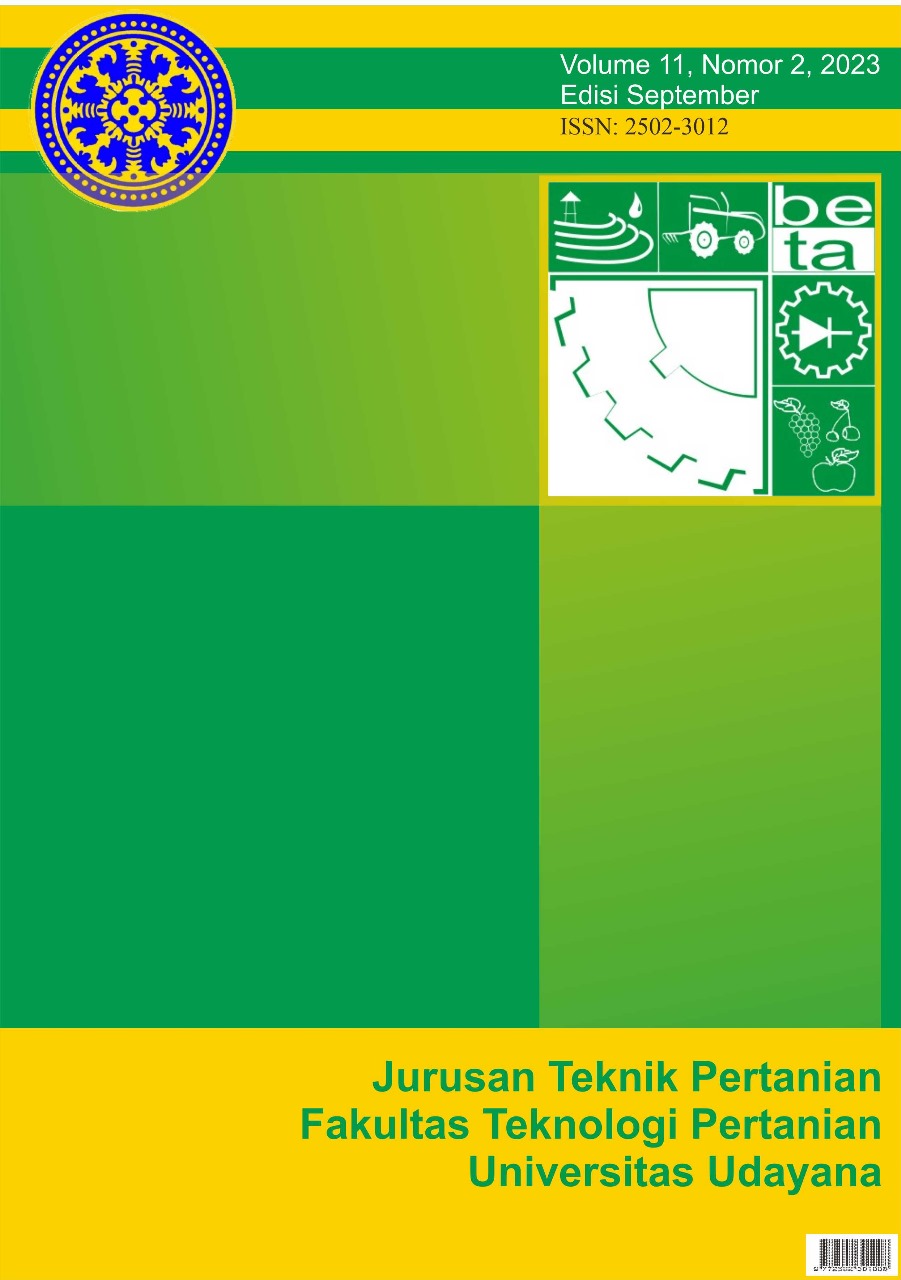Dinamika Suhu dan Kelembaban Udara pada Penyimpanan Kentang (Solanum tuberosum L.) Bibit Tipe Para-Para
Abstract
Abstrak
Petani di Bali belum mampu menghasilkan bibit yang baik akibat kegagalan di tahap penyimpanan dan masih tergantung pada bibit kentang kelompok G2-G4 yang didatangkan dari luar. Tujuan penelitian ini adalah untuk mengetahui dinamika suhu udara dan kelembaban udara (RH) selama penyimpanan kentang bibit dan perubahan fisik umbi bibit kentang hasil penyimpanan. Parameter yang diukur antara lain suhu dan kelembaban selama penyimpanan kentang, analisis neraca massa dan energi, perhitungan panas respirasi, panas untuk menaikan suhu kentang, panas untuk menguapan air serta panas yang hilang ke lingkungan dengan pendekatan model matematik sederhana. Hasil penelitian menunjukkan bahwa suhu cenderung membentuk pola polinomial orde dua atau kuadratik, sedangkan RH cenderung membentuk pola linier. Suhu ruang penyimpanan kentang berada pada kisaran 29,50 ºC - 29,09 ºC dan RH berada pada kisaran 73,00% - 81,80%. Nilai panas respirasi bervariasi antara 470,26 - 491,30 Watt. Panas yang dihasilkan dari proses respirasi adalah sebesar 72 -143 watt, panas untuk menaikan suhu umbi kentang sekitar kentang adalah 2,02 Watt; 1,81 Watt; 3,80 Watt; 2,60 Watt; 10,70 Watt; dan 15,20 Watt. Panas yang hilang ke lingkungan membentuk pola linier. Para-Para mampu menciptakan kondisi penyimpanan dan penyediaan oksigen yang, untuk perubahan fisik hampir tidak ada.
Abstract
Farmers in Bali have not been able to produce good seeds due to failures at the storage stage and are still dependent on potato seeds from the G2-G4 group imported from outside. The aim of this study was to determine the dynamics of air temperature and humidity (RH) during the storage of potato seeds and the physical changes of potato seed tubers after storage. Parameters measured included temperature and humidity during storage of potatoes, analysis of mass and energy balances, calculation of respiration heat, heat for increasing the temperature of potatoes, heat for water evaporation, and heat lost to the environment with a simple mathematical model approach. The results showed that temperature tends to form a quadratic polynomial pattern, while RH tends to form a linear pattern. The temperature of the potato storage room was in the range of 29.50 ºC - 29.09 ºC and the RH was in the range of 73.00% - 81.80%. Respiration heat value varies between 470.26 - 491.30 Watts. The heat generated from the respiration process is 72 -143 watts, the heat to raise the temperature of the potato tubers around the potatoes is 2.02 Watts; 1.81 Watts; 3.80 Watts; 2.60 Watts; 10.70 Watts; and 15.20 Watts. The heat lost to the environment forms a linear pattern. Para-Para is capable of creating conditions for the storage and supply of oxygen that, for physical change, are almost non-existent.
Downloads
References
Amarullah, M. R., Sudarsono, ., & Amarillis, S. (2019). Produksi dan Budidaya Umbi Bibit Kentang (Solanum tuberosum L.) di Pangalengan, Bandung, Jawa Barat. Buletin Agrohorti, 7(1), 93–99. https://doi.org/10.29244/agrob.v7i1.24753
Babarinsa, F. A., & Williams, J. O. (2015). Development of a diffuse light store for “ seed ” potato storage. International Journal of Agriculture and Earth Science, 1(8), 25–33.
Badan Pusat Statistik Indonesia. (2018). Statistik Tanaman Sayuran dan Buah- Buahan Semusim Indonesia 2018. BPS-Statistics Indonesia. https://www.bps.go.id/publication/2019/10/07/1846605363955649c9f6dd6d/statistik-tanaman-buah-buahan-dan-sayuran-tahunan-indonesia-2018.html
Badan Pusat Statistik Provinsi Bali. (2020). Produksi Kentang Provinsi Bali Menurut Kabupaten/Kota (Ton), 2019-2021. BPS-Statistics Indonesia. https://bali.bps.go.id/indicator/55/338/1/produksi-kentang-provinsi-bali- menurut-kabupaten-kota.html
David, J. H. dan J., & Kilmanun, J. C. (2016). Penanganan Pasca Panen Penyimpanan untuk Komoditas Hortikultura. Seminar Nasional Inovasi Teknologi Pertanian, 4(5), 1015–1026.
Eltawil, M. A., Samuel, D. V. K., & Singhal, O. P. (2006). Potato Storage Technology and Store Design Aspects. VIII(11), 1–18.
Kosasih, E. A., & Ronald, J. (2014). Pengaruh Laju Aliran , Kelembaban dan Temperatur Udara Pengering terhadap Kinerja Pengering Semprot pada Tekanan Udara Nozel Pneumatik 2 bar Absolut. Snttm Xiii, 15–16.
Murtado, A. D. (2014). Karakteristik Kimia Dan Fisik Kentang Selama Penyimpanan Dalam Kondisi Gelap. Journal of Chemical Information and Modeling, 3(1), 28–30.
Ndukwu, M. C., & Manuwa, S. I. (2015). Impact of evaporative cooling preservation on the shelf life of fruits and vegetable in South Western Nigeria. Research in Agricultural Engineering, 61(3), 122–128. https://doi.org/10.17221/54/2013-RAE
Purnomo, E., Suedy, S. W. A., & Haryanti, S. (2017). Pengaruh Cara dan Waktu Penyimpanan terhadap Susut Bobot, Kadar Glukosa dan Kadar Karotenoid Umbi Kentang Konsumsi (Solanum tuberosum L. Var Granola). Buletin Anatomi Dan Fisiologi, 2(2), 107. https://doi.org/10.14710/baf.2.2.2017.107-113
Purnomo, E., Widodo, S., Suedy, A., Haryanti, S., & Biologi, J. (2014). Perubahan Morfologi Umbi Kentang Konsumsi (Solanum Tuberosum L. Var Granola) Setelah Perlakuan Cara Dan Waktu Penyimpanan Yang Berbeda. Jurnal Biologi, 3(1), 40–48.
Setiyo, Y., Gunadnya, I. B. P., Gunam, I. B. W., & Susrusa, I. K. B. (2017). The implementation of low external input sustainable agriculture












 Jurnal BETA (Biosistem dan Teknik Pertanian)
Jurnal BETA (Biosistem dan Teknik Pertanian)


